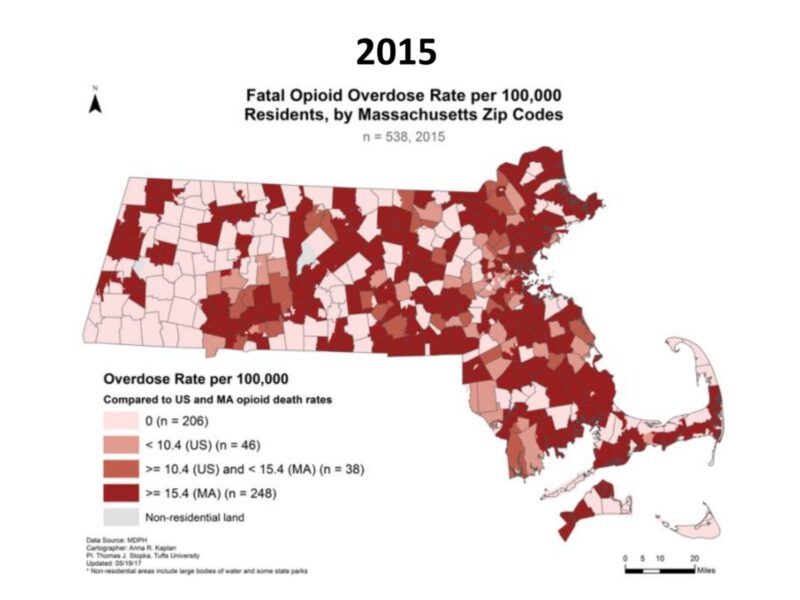Burden of Opioid Epidemic Mapped in Massachusetts Using a Unique Dataset

Using a legislatively-mandated, integrated dataset, the Massachusetts Department of Public Health has published its first comprehensive look at the state’s opioid-related overdoses between 2011 and 2015. The dataset was created as part of 2015 “Chapter 55” legislation. It links information on an individual level across diverse state databases, including mental health data, jail and prison data, vital records, substance abuse treatment data, prescription drug monitoring program (PDMP) data, ambulance trip information, and many others. It then maps this information to the Massachusetts all-payer claims database. The findings highlight the need to improve treatment access for people who experience a non-fatal overdose, and to tailor treatment to the needs of vulnerable populations. Here we highlight a few of the findings:
- 4% of Massachusetts residents over the age of 11 have an opioid use disorder and this population is growing.
- The number of non-fatal overdoses increased by about 200% between 2011 to 2015, totaling more than 65,000. About 1 in 5 of them were young adults.
- Veterans were at high risk for fatal and non-fatal overdoses with higher prevalence of serious mental illness and homelessness.
- Former prison inmates had 50 times the risk of an overdose than the general public, with the highest risk occurring in the first month of release.
- Repeat overdoses were common, with 14.9% having one or more repeat overdoses within one year and 19.1% within two years. Of those who had a non-fatal overdose, 6.2% experienced a fatal overdose within one year and 9.3% experienced a fatal overdose within two years.
- In 2013-14, 2,192 people died of opioid-related overdoses.
- According to ambulance data, naloxone was administered in 40% of overdose events and the number of naloxone administrations has increased.
- Only 25%-35% of those who experienced a non-fatal overdose received treatment afterwards. The likelihood of receiving treatment and the type of treatment depended on the age of the individual.
The Chapter 55 dataset is a unique resource for substance use researchers, who are leveraging it to better understand the opioid epidemic in Massachusetts in different communities. Many of the findings described in the report could not have been discovered without linking across several datasets. Several states have the capacity to create similar datasets starting from their existing all-payer claims database, and Maryland has already taken steps to do so.
We asked Brendan Saloner, a CHERISH Research Affiliate and Assistant Professor at Johns Hopkins School of Public Health in Baltimore, Maryland to comment. He told us that “Massachusetts should be commended for creating a data sharing framework that will enable the state to use evidence to inform policymaking. The public health response to the opioid epidemic across the country has been hindered by the fact that we have a limited understanding of how populations most closely affected by the epidemic interact with different health and social service systems. With the information being linked under Chapter 55, researchers will be able to measure factors that increase risk for overdose, align resources with existing needs, and test possible models for policy response. In short, Chapter 55 creates the basis for a system where different entities can finally begin to work together on a shared challenge.”